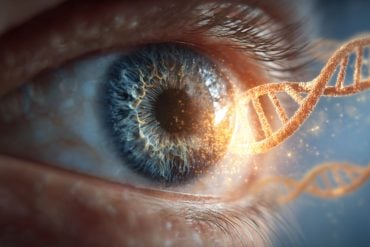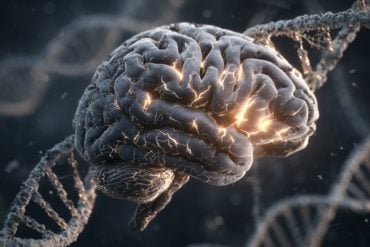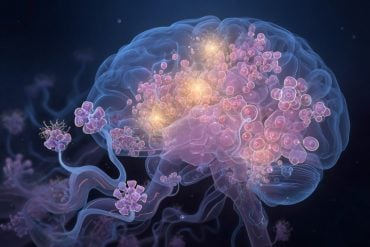Summary: A groundbreaking study has shown that as children age, excitatory brain activity decreases while inhibitory activity increases, helping shape healthy brain development. Using a wearable quantum brain scanner, researchers measured gamma waves in over 100 individuals aged 2 to 34.
The scanner, designed with optically pumped magnetometers (OPMs), allows for noninvasive brain imaging even in very young children. This method opens new doors for understanding and diagnosing neurodevelopmental conditions like autism much earlier than previously possible.
Key Facts:
- Excitation-Inhibition Balance: Excitatory processes decline and inhibitory processes rise with age.
- Wearable MEG Technology: A child-friendly scanner captures real-time brain activity in even toddlers.
- Clinical Relevance: Establishes a developmental benchmark to better understand disorders like autism.
Source: University of Nottingham
A new study has shown how aspects of brain function change with age, revealing that excitatory processes in the brain decrease, while inhibitory processes increase as children get older.
The findings are an important step in understanding disorders like autism.

Brain function is based on a delicate balance of excitatory processes (which make brain cells fire) and inhibitory processes (which stop brain cells firing) – this is known as the E-I balance. Usually, to measure this, sensors would need to be placed in the brain (which requires experimental surgery and so cannot be routinely done in humans).
In this new study, published today in Imaging Neuroscience, scientists have shown that it can be measured using a novel wearable brain scanner.
Researchers from the School of Physics and Astronomy at the University of Nottingham and The Hospital for Sick Children (SickKids) in Toronto scanned the brains of 101 healthy children and adults between the ages of 2 and 34 years.
Using a wearable design of magnetoencephalography (MEG) scanner, the team were able to measure high frequency brain waves (known as gamma waves) that are generated in brain circuits that rely on both excitatory and inhibitory inputs.
The researchers showed that gamma waves change significantly with age, with low amplitude broadband waves in children and high amplitude narrowband waves in adults.
Using biophysical models of the measured gamma waves, the research team were then able to translate their findings into measurements of E-I balance, showing that as children get older excitatory processes decrease, while inhibitory processes increase.
This trajectory is critical for healthy brain development and is understood to be atypical in older children and adults with psychiatric disorders. This provides a benchmark (in typically developing young children) against which disorders like autism can be understood.
Psychiatric disorders are due to atypical brain function, which can be measured with a range of brain imaging technologies, such as MRI, EEG and MEG. Childhood disorders, however, can emerge in the early years of life (2-4 years of age), but there are limited ways to investigate the brain function in children who are this young.
The wearable brain scanner is based on quantum technology, and uses LEGO-brick-sized sensors – called optically pumped magnetometers (OPMs) – which are incorporated into a lightweight helmet to measure the magnetic fields generated by brain activity.
This unique design means the system can be adapted to fit any age group, including very young children. The system takes only seconds to set up, and children wear it and can move freely during a scan. It is therefore ideally suited to scanning children.
Professor Matthew Brookes from the University of Nottingham’s Sir Peter Mansfield Imaging Centre has led the development of the new technology which is now being installed across the world by Nottingham-based spin-out company Cerca Magnetics, he said: “Quantum technologies have revolutionised what is possible with brain imaging. 10 years ago measuring MEG signals in very young children as they move around freely, whilst wearing what is essentially a hat, seemed like science fiction.
“Now, it’s possible and it’s opening up new worlds of possibility – particularly related to the developing brain in the early years of life.”
World renowned neuroscientist Dr Margot Taylor – who leads autism research at the Hospital for Sick Children in Toronto – said: “OPM technology allows us to complete studies in young children that were simply not possible otherwise.
“We are able to obtain fantastic data in one-year-olds; our next frontier is having the same success in infants from birth.
“We expect that these studies will give us better understanding of the early onset of neurodevelopmental disorders, which will help in the care of the children in the future.”
This study was led by Dr Natalie Rhodes who, following undergraduate and postgraduate study at the University of Nottingham, moved to Toronto to continue her scientific career.
She said: “Just like a well-tuned orchestra, our brains rely on a delicate balance of signals. We now have a way to measure how this balance changes from early life to adulthood and can use this to better understand developmental differences in conditions like autism.
“We know that an imbalance in brain signals is linked to neurodevelopmental conditions, but until now, we haven’t had a suitable method to measure it in young children. Using OPM technology, we can now study brain function with unprecedented precision from very young children.”
The University of Nottingham launched Cerca Magnetics in 2020 to commercialise OPM-MEG scanners and related technologies. The wearable system has been installed in a number of high profile research institutions across the globe, including at SickKids in Toronto where around half of the volunteers in the current study were scanned.
The research teams in both institutions are working together to expand the range and extent of neurodevelopmental data, in both healthy and atypical brain populations.
Funding: The study was supported by a healthcare impact partnership grant, awarded by the Engineering and Physical Sciences Research Council (EPSRC) in the UK. The authors have also wish to acknowledge the UK quantum technologies programme and in particular the Quantum Hub for Sensors Imaging and Timing (QuSIT).
The work at SickKids was supported by the Simons Foundation Autism Research Initiative (SFARI; 2021) and the Canadian Institutes of Health Research (CIHR).
About this neurotech and brain aging research news
Author: Emma Thorne
Source: University of Nottingham
Contact: Emma Thorne – University of Nottingham
Image: The image is credited to Neuroscience News
Original Research: Open access.
“Measuring the neurodevelopmental trajectory of excitatory-inhibitory balance via visual gamma oscillations” by Natalie Rhodes et al. Imaging Neuroscience
Abstract
Measuring the neurodevelopmental trajectory of excitatory-inhibitory balance via visual gamma oscillations
Disruption of the balance between excitatory and inhibitory neurotransmission (E-I balance) is thought to underlie many neurodevelopmental disorders; however, its study is typically restricted to adults, animal models, and the lab-bench.
Neurophysiological oscillations in the gamma frequency band relate closely to E-I balance, and a new technology—OPM-MEG—offers the possibility to measure such signals across the lifespan.
We used OPM-MEG to measure gamma oscillations induced by visual stimulation in 101 participants, aged 2–34 years.
We demonstrate a significantly changing spectrum with age, with low-amplitude broadband gamma oscillations in children and high-amplitude band limited oscillations in adults.
We used a canonical cortical microcircuit to model these signals, revealing a significant decrease in the ratio of excitatory to inhibitory signalling with age in the superficial pyramidal neurons of the visual cortex.
Our findings detail the first MEG metrics of gamma oscillations and their underlying generators from toddlerhood, providing a benchmark against which future studies can contextualise.






